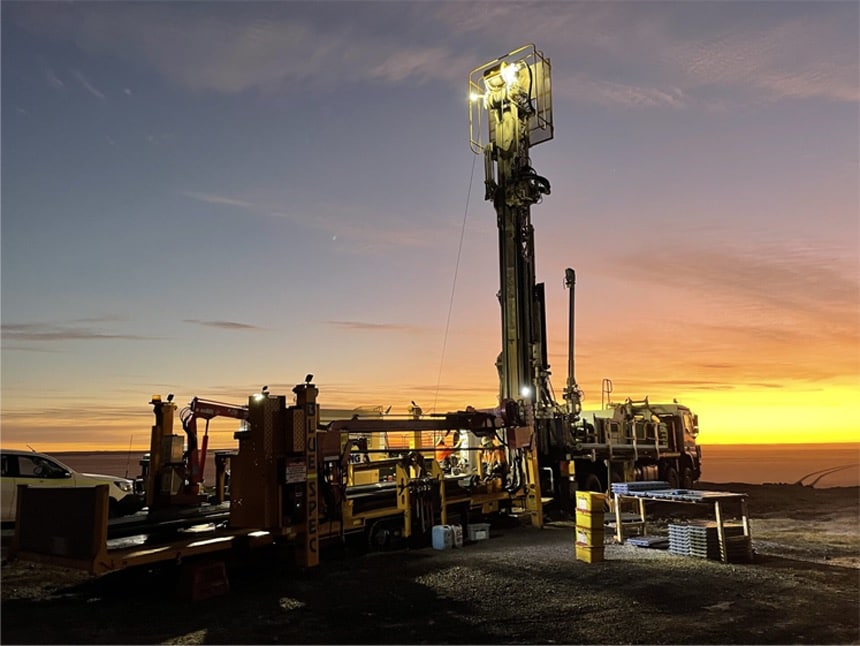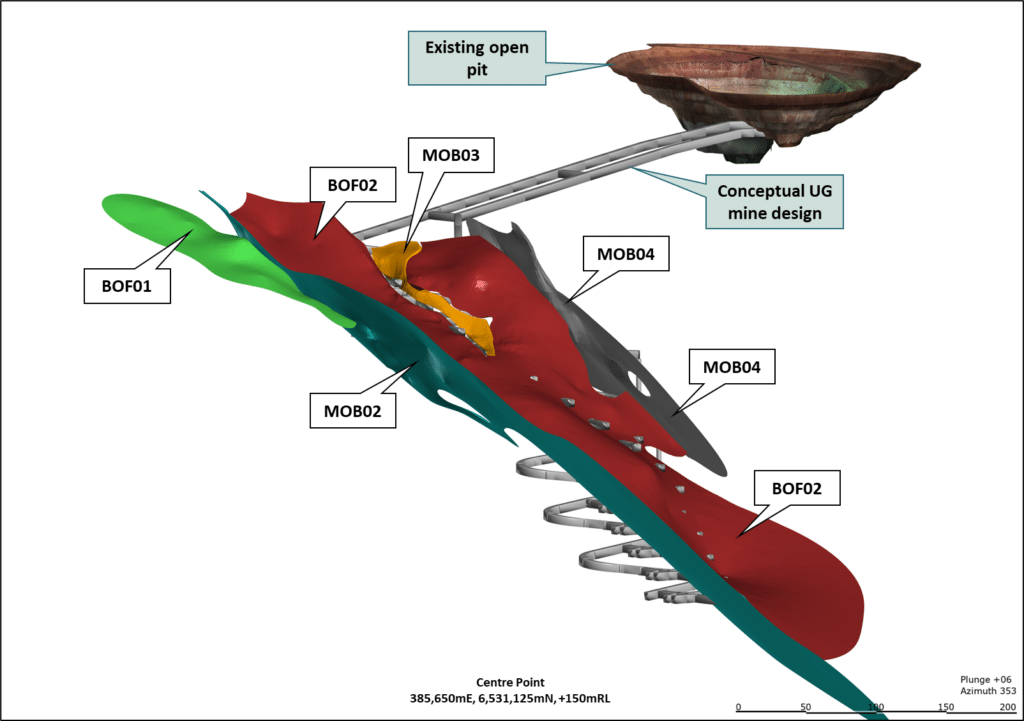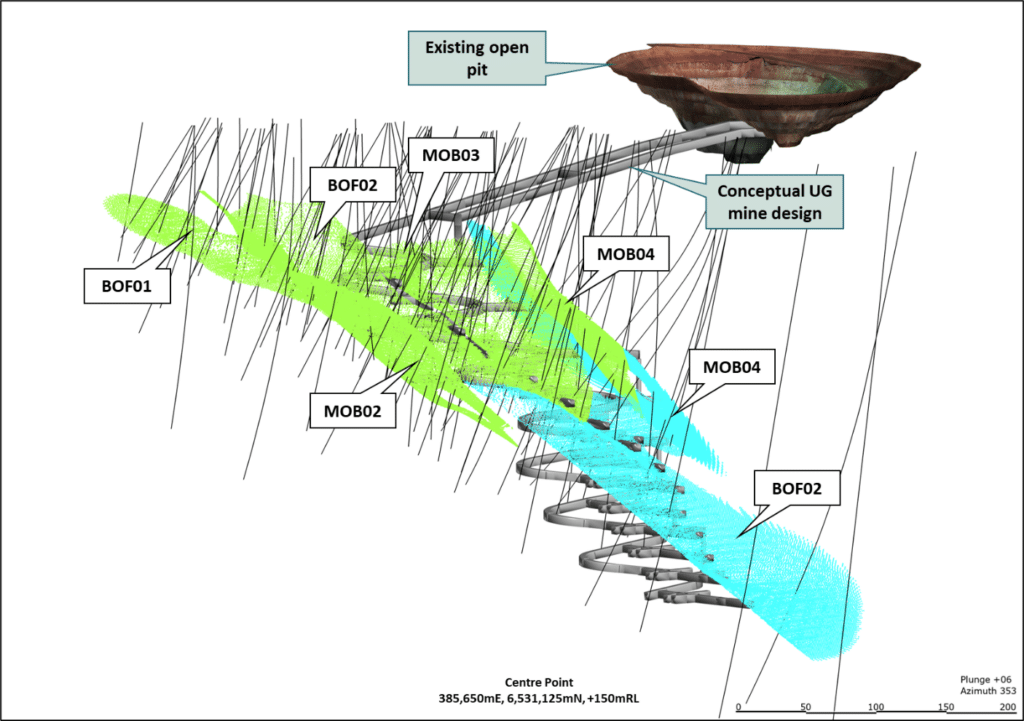

Baker Project Overview
Discovery and Exploration History of the Baker Nickel Deposit
The Baker nickel deposit was discovered by Lunnon Metals. The area in which it is hosted, termed East Cooee, had been drilled historically by WMC however, despite a broadly spaced grid of diamond drilling, WMC did not progress the identified nickel mineralisation at the base of the second flow unit of the hanging wall Kambalda Komatiite. Accordingly, there has been no historical production from the area.
Initial Ore Reserve/ PFS Results
Summary of the Baker Deposit Pre-Feasibility Study Results
On 22/05/2023, the Company announced the Pre-Feasibility Study (PFS) results for the Baker Deposit, revealing a Probable Ore Reserve of 612,000 tonnes at 2.86% Ni, totaling 17,500 tonnes of contained nickel. Key highlights of the study included:
- Strong financial returns with low start-up capital requirements.
- Initial Probable Ore Reserve of 612kt averaging 2.86% Ni for 17.5kt contained nickel.
- Indicated Mineral Resource converted 73% to Ore Reserve.
- Pre-tax and post-tax free cash flow generation of $196 million and $145 million.
- Pre-tax NPV¬8% of $164 million and 324% internal rate of return (IRR).
- Pre-production capex of $18.6 million, maximum cash drawdown of $26.4 million including working capital.
- A premium sulphide concentrate, averaging ~14.6% Ni, Fe:MgO ratio of ~18.8 and low arsenic of ~440ppm.
- Detailed offtake discussions can now commence for Baker’s high grade nickel sulphide ore.
Importantly, significant upside potential from the initial base case outlined in the PFS remains due to the fact that no Inferred Mineral Resources were included in the Study, the PFS did not consider any likely future extensions to Baker with the deposit remaining open down plunge and the potential for contribution from East Trough deposit (approx. 450m from Baker) and most relevantly any scale and synergy from interaction with the Foster Mine’s Mineral Resources.
Details of the PFS and a summary slide deck capturing the key points can be found at the following links:
PFS Report and Slide Deck.
December 2022 Update to Mineral Resource
- Updated Mineral Resource estimate for Baker materially increased to 929,000 tonnes at 3.3% nickel for 30,800 contained nickel tonnes
- Baker Indicated Resource nearly three times larger, representing 78% of contained nickel metal and at 3.8% Ni, is 37% higher grade than reported in June 2022
- Baker confirmed as cornerstone asset less than 12 months after first high-grade nickel assays heralded its discovery on 17 January 2022
- Result of aggressive 15km reverse circulation and 4.4km diamond drilling campaigns, completed in under 18 months
- Global JORC 2012 nickel Mineral Resource estimate at the Kambalda Nickel Project has grown by a further 23% to 2.6 million tonnes @ 3.1% nickel for 79,300 contained nickel tonnes
- More than double the Mineral Resource reported at listing on the ASX (June 2021)
An Exploration Target range for East Cooee area that covered the Baker despoit was estimated by the Company in 2020 in accordance with the guidelines of the JORC Code 2012 and contained in its Prospectus at the Initial Public Offering of Lunnon Metals. This work identified multiple mineralised surfaces in basalt-ultramafic contact trough locations, contact flanking locations, footwall positions and extensive hanging wall surfaces. Lunnon Metals budgeted for drilling in its Prospectus to test the Exploration Target within 18 months of listing. This drilling led directly to the discovery of Baker.
Baker deposit is over 2.5km distance from the Foster Nickel Mine (straight line) and between 3.10km to 4.75km when measured along the prospective komatiite-basalt contact (subject to depth on this contact) and as such represents a completely separate mineralised position from the Company’s existing JORC 2012 compliant Mineral Resource of 48,500 nickel tonnes.

Geology
The Baker nickel mineralisation is part of an extensive perched hanging wall position historically drilled by WMC on a broad spacing and now in-filled to close spacing by Lunnon Metals. The Company’s exploration programme since its IPO in June 2021 has delivered a significant increase in drill coverage (36 RC holes and three diamond drill holes, all completed in 2021) which has allowed for a greatly improved geological model and understanding of the controls to mineralisation. Importantly, this drilling has identified thicker, higher grade nickel mineralisation which defines the Baker deposit.
The majority of the mineralisation is interpreted to be hosted at the base of a hanging wall komatiite flow located 30 to 50 metres above the more traditionally prospective basal komatiite flow in contact with the Lunnon Basalt footwall. Two late east-dipping steeper structures are identified which crosscut, offset, and structurally thicken the base of flow mineralisation locally.
The western one, which hosts significant re-mobilised massive nickel sulphide itself, has a dip of 42⁰ towards 066⁰. The structure is identified as a steep conductive surface in both Down Hole Transient Electromagnetic and surface Fixed Loop Electromagnetic surveys during exploration by Lunnon Metals.
Updated Mineral Resource Estimate
The breakdown of the updated Mineral Resource estimate, as at 7 December 2022, and at 1.0% Ni cut-off grade is as follows. The results reflect a combination of massive nickel sulphide, adjacent matrix and disseminated nickel sulphide mineralisation within each Mineral Resource classification.


Reasonable Prospects for Eventual Economic Extraction (RPEEE)
Despite Baker’s lack of prior mining, the Company’s KNP features extensive existing mining infrastructure, enhancing the feasibility and reducing the costs of potential future development and mining activities, including at Baker. The project is situated on granted Mining Leases. Development or mining initiation at Baker necessitates submitting a Mining Proposal/Mine Closure Plan to the Western Australian Department of Mines, Industry Regulation and Safety, accompanied by a comprehensive mine risk assessment. The updated Baker Mineral Resource significantly contributes to the technical evaluation needed for these submissions.


The grades and geometry of Baker’s nickel mineralisation are amenable to small-scale underground mining. Many nickel surfaces mined historically in the immediate vicinity of Baker exploited similar style mineralisation hosted at the same stratigraphic position i.e., the base of the second ultramafic flow (e.g. at Jan Shoot, 2.6km to the south, production 1972-1986 1.07Mt @ 2.8% Ni for 30.3kt nickel metal). It is assumed that the Baker Mineral Resource could be mined via underground methods. Potential dilution and ore loss during future underground mining have been considered in application of the reporting cut-off of 1.0% Ni.
Presently, it is forecast that no processing capital will be required as future nickel ore would likely be sent to the nearby BHP Nickel West Kambalda Nickel Concentrator with that company retaining a right of pre-emption in relation to any proposal by Lunnon Metals to enter into any sales contract or other sales arrangement to realise any revenue or other benefit from the treatment or sale of nickel ore.
In light of the generally shallow nature of the Baker Mineral Resource and its proximity to the nearby West Idough open pit (likely underground access point, see the conceptual mine design represented above), future mine development and start-up capital costs are considered to be modest. In regard to operating costs, publicly available data for recent feasibility studies for similar projects (e.g., Mincor Resources Kambalda Nickel Project, Mincor, 2020) assumed operating and sustaining capital costs of approximately AUD 250 per tonne. Combining such estimates with theoretical diluted nickel production from a future Baker nickel mining scenario and then applying the current nickel price in AUD terms generates positive notional cash flows at Baker assuming metallurgical plant recoveries and nickel payability terms recorded in the local district with the likes of BHP Nickel West or others.
The initial metallurgical test work at Baker was completed and reported to the ASX on 1 September 2022. The composite sample analysed comprised 170kg of diamond drill core recovered at the end of 2021, from the only three diamond holes completed at that point in time. The Company highlights that these samples were collected and this test work commenced prior to the completion of the geological interpretation and reporting of the first-time Baker MRE in June 2022. As a consequence, over 40% of the core samples collected originated from outside the MRE interpreted model, with this additional material predominantly being sourced from the weakly mineralised hanging wall komatiite to make up the sample weight required.
Summary results were as follows:
- Composite Sample calculated head grade: 2.81% Ni, 0.27% Cu, 0.057 % Co, 16.4% Fe, 20.6% MgO, 7.29% S, 18 ppm As
Results of the Rougher/Cleaner optimisation tests conducted at a grind size of P80 53 µm:
- Nickel recovery was 86% with a concentrate grade of 16.9% Ni;
- Copper recovery 95.5% with a concentrate grade of 1.88% Cu;
- Cobalt recovery 85.3% with a concentrate grade of 0.35% Co;
- Arsenic in concentrate graded 95 ppm; and
- Other concentrate measures included Fe:MgO ratio of 16.8 and sulphur at 36.8%;
These initial tests carried out on samples collected prior to the establishment of the Baker MRE, but in close proximity to it, delivered extremely promising results based on the metallurgical processing route at the Nickel West concentrator. The test work showed high nickel recoveries whilst producing a very clean concentrate, low in contaminates and high in saleable nickel, copper and cobalt. Further metallurgical analysis will now be conducted based on the domains in the updated Baker MRE model. The Company expects to improve on the initial summary results noted above.
Note about the Exploration Target: Baker deposit originally fell within the broader East Cooee Exploration Target reported in the Company’s Prospectus lodged on 11th June 2021. The combined tonnage and grade potential of the Exploration Target was estimated to be in the range of 500 kt to 750 kt with an average grade of 1.25% to 2.5% nickel. Although the Baker deposit Mineral Resource now exceeds and has outperformed the original Exploration target, there was nickel mineralisation estimated in the target range for the remainder of the area present on the East Trough and West Trough prospects, both of which are still valid discovery targets.
Sign Up for ASX Alerts and News to receive the latest updates, insights, and developments directly to your inbox.